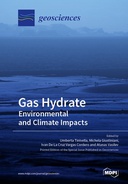Explore

Gas Hydrate
0 Ungluers have
Faved this Work
Login to Fave
This Special Issue reports research spanning from the analysis of indirect data, modeling, and laboratory and geological data confirming the intrinsic multidisciplinarity of gas hydrate studies. The study areas are (1) Arctic, (2) Brazil, (3) Chile, and (4) the Mediterranean region. The results furnished an important tessera of the knowledge about the relationship of a gas hydrate system with other complex natural phenomena such as climate change, slope stability and earthquakes, and human activities.
This book is included in DOAB.
Why read this book? Have your say.
You must be logged in to comment.
Rights Information
Are you the author or publisher of this work? If so, you can claim it as yours by registering as an Unglue.it rights holder.Downloads
This work has been downloaded 286 times via unglue.it ebook links.
- 53 - pdf (CC BY-NC-ND) at Unglue.it.
Keywords
- active margin
- Amazon fan
- Arctic shelf
- biogenic gas
- blue growth
- Bouguer anomaly
- BSR
- Carbon Dioxide
- Chile Triple Junction
- Chilean margin
- clathrites
- Climate Change
- earthquake
- Eastern Mediterranean
- ecosystem
- Environmental impact
- gas hydrate
- gas hydrates
- gas seeps
- geohazard
- geohazards
- global change
- gravimetric data
- hydrate dissociation
- isotopic composition
- Levant Basin
- magnetic data
- mantellic source
- Methane
- methane cycle
- methane emission
- methane stability
- Miocene
- modeling
- modelling
- molecular composition
- multidisciplinary
- natural gas hydrate
- northern Apennines
- ocean acidification
- permafrost
- potential methods
- Reference, information & interdisciplinary subjects
- Research & information: general
- Risk assessment
- salt migration
- Santos Basin
- São Paulo Plateau
- seep-carbonates
- seepage
- seismic interpretation
- slope stability
- subaqueous permafrost
- temperature increase
- thawing
- thermogenic gas
Links
DOI: 10.3390/books978-3-03921-845-5Editions


